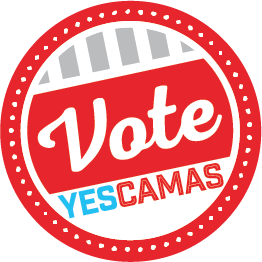Your Levy questions…answered.
Why can't the district operate within its current budget and make the necessary adjustments for the expiration of a previous levy?
The Camas community has supported schools through local levies for more than 40 years. Initially, levies provided money for things that could not be funded by the State, or basic education, dollars like extra-curricular activities. Over time, state funding did not keep pace with actual costs, and lawmakers pushed the burden on local communities to fill the gap with levy dollars.
Our EP&O levy makes up about 15% of our budget. If we were to align our budget to State and Federal funding, we could not continue extra-curricular activities. Classroom sizes, breakfast and lunch prices, and the length of time students spend on the bus would all increase. Additionally, many employees would lose their jobs. The amount of money we would have to maintain or replace computers, roofs, and HVAC systems would be almost non-existent.
Most of our parents cite Camas Schools as the reason they moved to Camas. It is our community support that makes our schools strong and vibrant.
What positions does the levy fund?
The levy funds staffing above what the state provides funding for. This includes additional counselors, librarians, and Special Education teachers. It also pays for additional paraeducators, secretaries, security staff, grounds and maintenance, bus drivers, technology staffing, substitute teachers, and school nurses.
Why do we need to have local levies? I thought the state was supposed to fund our schools.
The state does not fully fund the programs and services we must provide and how we enhance our current programming. For example, the state funds 85% of our special education programs, and we receive no funding to support extracurricular activities like sports. Approximately 15% of the district’s annual funding comes from local levy dollars.
Does the levy support extracurricular programs?
Yes, 100% of the staff who manage extracurricular programs, such as coaches, band teachers, and club leaders, are levy-funded.
Where does the money come from to pay for the levy’s ballot mailing and what is the reason, if any, for not having included the levy on the general election’s ballot?
The money comes from the General Fund and the estimated cost is $45,000. Generally speaking, most districts choose to run levies in February as it allows the school board to assess the current school year and run the election prior to when they build the next school year’s budget.
What would happen if the levy failed?
The programs and positions funded by the levy would face elimination or heavy staffing reductions, including teaching positions, classroom support, school sports, music, art, counseling, safety, and nursing.
If the Levies do not pass on the February ballot I understand we can try again later this spring. If that second try doesn’t pass either, how long do we have to wait for a 3rd try at passing it?
Yes, the school board would likely bring the replacement levies back to voters in April so that, in the event of a second failure, we could meet the deadline of notifying staff of layoffs by May 15 for teachers and June 1 for classified staff. We are only allowed to put our levies to a vote twice in a calendar year, so the next earliest attempt would be in February 2025.
Where can I get more information about the levies?
A school district can, and must, provide information about proposed levies to the citizens of the community. The school district puts levy information on the district website and mails a levy brochure to all community residents. Go to the Camas School District website at www.camas.wednet.edu. Community members are also welcome to contact the district’s communication office at 360-833-5563, the Superintendent’s office at 360-833-5412, a school board member, or their local school principal.


